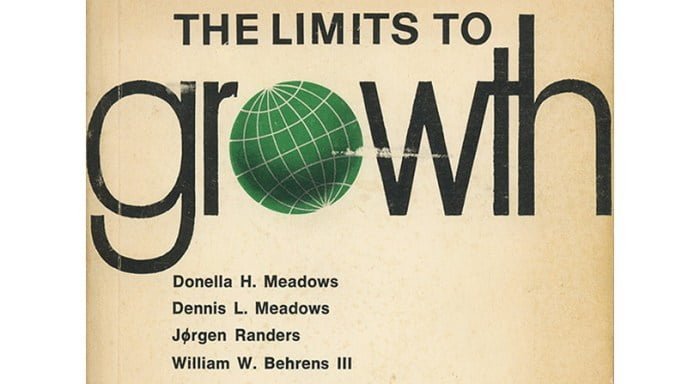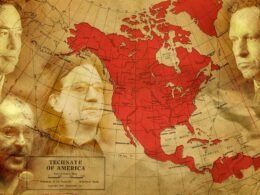Today’s world is faced with two possible future systems. On the one hand, there is a multipolar approach in defense of sovereign nation states premised on long-term thinking, scientific optimism and win-win cooperation stands as one possible outcome; on the other, there is a unipolar paradigm of world government, depopulation and zero-sum thinking.
Gaining insight into these two opposing paradigms is more important now than ever before, and one important place to start is the genesis of the ideologies that motivate the “Great Reset Architects” who are pushing society into a “Fourth Industrial Revolution” – a “revolution” where it is believed that automation, and Artificial Intelligence will render most of humanity obsolete. We are told that this post-reset age will also see a merging of humanity with machines, a future scenario heralded by figures like Elon Musk and Google’s Ray Kurzweil in order to “stay relevant” in the next phase of our evolution. Davos-man Yuval Harari has echoed these sentiments, arguing that the levers of evolution will now be moved from the randomness of nature into the new gods running Google, Facebook and the WEF.
In a 2018 WEF sermon, Harari acted as a neo-Darwinian prophet of a new transhumanist age, saying:
“We are probably among the last generations of homo sapiens. Within a century or two, Earth will be dominated by entities that are more different from us, than we are different from Neanderthals or from chimpanzees. Because in the coming generations, we will learn how to engineer bodies and brains and minds. These will be the main products of the 21st century economy.”
This Borg-like deterministic faith in the human-machine synthesis that pervades the thinking of all modern transhumanists is both cultish, creepy and just plain wrong. However, without a proper evaluation of the historic roots of these ideas, which threaten to push global civilization into a dystopian nightmare, it is impossible to understand anything fundamental about the past 250 years of human experience, let alone see where the fatal flaws lie within the Great Reset/Transhumanist operating system. That system, of course, is simply a repackaged system of eugenics under a new name that was developed in the aftermath of World War II.
Leading transhumanist godfather (and president of the British Eugenics Society) Sir Julian Huxley enunciated this post-WW2 objective explicitly in his 1946 UNESCO founding manifesto saying:
“Even though it is quite true that any radical eugenic policy will be for many years politically and psychologically impossible, it will be important for UNESCO to see that the eugenic problem is examined with the greatest care and that the public mind is informed of the issues at stake so that much that is now unthinkable may at least become thinkable.”
There are a few fundamental things that should be understood about the psuedo-science of eugenics, otherwise known as “the science of cleansing the human gene pool of undesirable pollution”, which emerged at the end of the 19th century. Imagining a future age where the science of eugenics would replace religion, the school’s founder Sir Francis Galton (cousin to Charles Darwin) mused in 1905: “It is easy to let the imagination run wild on the supposition of a whole-hearted acceptance of eugenics as a national religion”.
Closed vs Open Systems Clash in the 19th Century
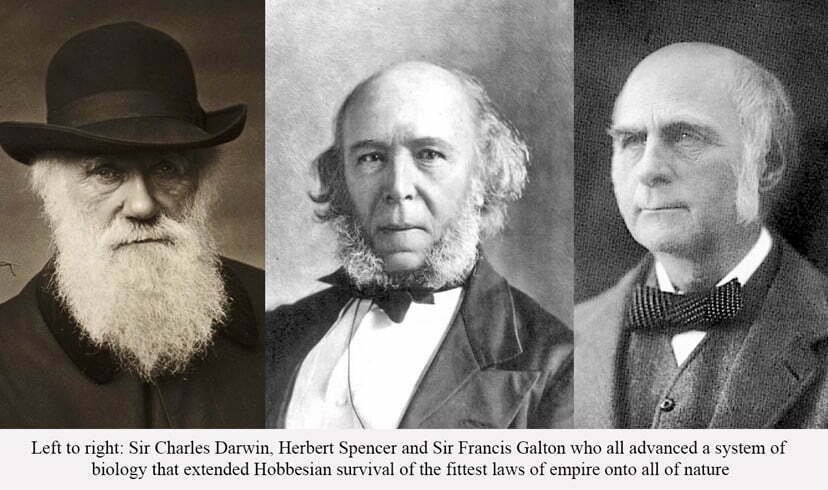
The entire system of eugenics advocated by Galton, Huxley et al were merely a repackaging of the underlying assumptions of the theories of population popularized by the British East Company’s star economist Thomas Malthus (1766-1834). Malthus promoted the mathematical thesis that population levels will always tend towards geometric growth, while agricultural resources will tend to arithmetic growth resulting in relatively forecastable “crisis points”. Malthus and his disciples, known as “Malthusians”, believed that social engineers representing the British Empire must use these “crisis points” to scientifically manage the “human herd”.
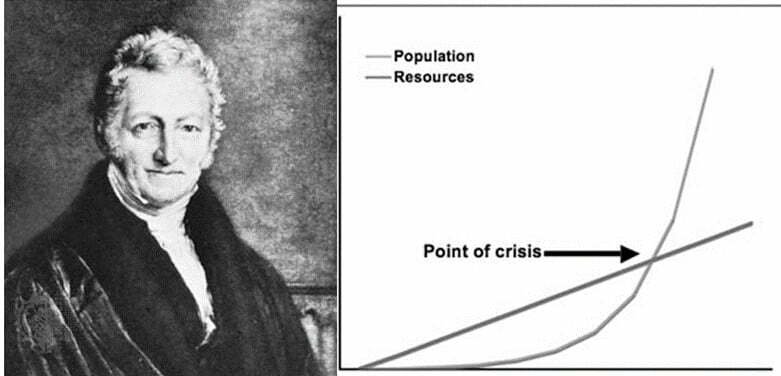
Malthus believed that nature bestowed upon the ruling class certain tools that would allow them to accomplish this important task (namely war, famine and disease). Malthus coldly stated the following in his 1799 Essay on Population:
“We should facilitate, instead of foolishly and vainly endeavoring to impede, the operations of nature in producing this mortality; and if we dread the too frequent visitation of the horrid form of famine, we should sedulously encourage the other forms of destruction, which we compel nature to use. In our towns we should make the streets narrower, crowd more people into the houses, and court the return of the plague.”
Taking this cold logic to its extreme, the “reverend” Malthus extended his logic to the “practical” elimination of unfit children whose value is “comparatively” low to society:
“I should propose a regulation to be made, declaring that no child born from any marriage taking place after the expiration of a year from the date of the law, and no illegitimate child born two years from the same date, should ever be entitled to parish assistance… The infant is, comparatively speaking, of little value to society, as others will immediately supply its place.”
Britain’s implementation of Malthus’s ‘science’ of population management was vicious. In England, the Poor Laws of 1838 ensured that no state assistance beyond workhouses would be provided for masses of impoverished subjects of the Empire. Between 1845-1851, the repeal of the Corn Laws and Irish Potato Famine resulted in a million Irish dying of famine in a land with plentiful harvests. At the time, Free Trade agreements demanded export quotas be maintained even at gun point, despite mass starvation. In 1877 alone, over ten million Indians died of British-directed famines as Malthus’s system was applied in full force, and throughout the British empire.
Toward the end of the 19th century, this closed unipolar system represented one centralized command structure that sought to keep all global cultures and nations subdued to the demands of “the most fit”. Yet, its dominance was wearing thin. In opposition to the dismal science of the British social engineers, an opposing paradigm was spreading like wildfire, one which saw the human mind and its capacities to discover laws of creation as primary to all rules which oligarchs demanded be obeyed.
Russia and the Ottoman Empire had been burned badly by British geopolitical manipulations during the Crimean War; Indian uprisings had shaped the entire 1859-1861 period; and the brutalization of the Chinese in the wake of the costly 2ndOpium War sent shockwaves of indignation to sympathizers across the world. Most importantly, the union’s ability to survive a four-year, British-manipulated Civil War (largely due to Russia’s intervention in 1863) was a game changer. While Britain’s over extended (and over-bloated) system of empire trembled under its own rigidity, a new system of cooperation, protectionism, rail development, industrial growth, national banking and technological progress began to spread across the world, threatening to undo the closed system of hereditary power which had maintained control for eons.
The prospect of a coalition of nations developing their resources as land powers, with rail, industrial growth, protectionism and national banking procedures was anathema to the British Empire’s basis of global looting: private finance free trade, cash cropping and a general dependency on British Maritime supremacy.

The Rise of Thomas Huxley’s X Club
Empires never disappear without a fight, and the British Empire was no exception. Before the Civil War in the USA had concluded, a new imperial grand strategy was reformulated in Cambridge and in the London headquarters of the British Royal Society.
Out of these networks came a new breed of imperial management under the form of Huxley’s X Club (c.1865) , which led by a young, talented misanthrope named Thomas Huxley (aka: ‘Darwin’s Bull Dog”). Huxley was tasked with formulating a new grand strategy to preserve the empire.
Reflecting upon the growth of German, Russian and American industrialization and cooperation, Huxley wrote in 1887 that Britain was entering “upon the most serious struggle for existence to which this country was ever committed. The latter years of the century promise to see us in an industrial war of far more serious import than the military wars of its openings years.”
Knowing that the most important level of warfare is found in the scientific conceptions held by society (since our standard for political self-regulation is ultimately founded upon and informed by standards and laws found in nature), Huxley’s X Club aimed to unite all major branches of physics, biology, economics and sociology under a singular coherent interpretation based on gradualist, descriptive, reductionist science. This would be a new unified, internally consistent science that would iron out the evidence of all creative leaps which shape all living and non-living nature. This group realized that if nature could be modelled as a closed, decaying and random process, then it would also be devoid of any actual notion of principle, justice, or morality. This would be a conception of nature which empires could forever justify the exploitation of their victims.
Describing the X Club, historian Jules Evans wrote:
“Like a Roman phalanx, the X-Club defended the cause of Darwinism and scientific naturalism (i.e the belief that God and other supernatural entities did not exist or at least did not intervene in the natural world). The members also used their influence to support each other’s work, and win the top jobs for themselves and their allies. It was a new guild, a new priesthood.”
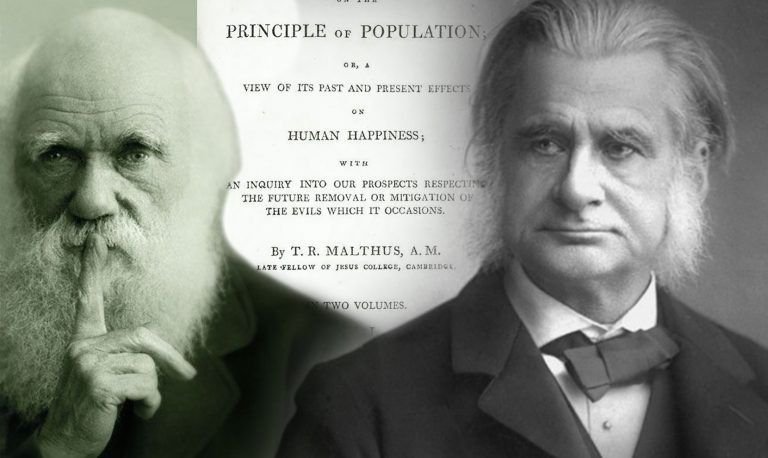
The ‘meta system’ uniting all of these various branches of descriptive “science” would be premised on Charles Darwin’s theories of natural selection and “survival of the fittest”. The supposed need for human society to weed out the unfit was premised on certain fundamental assumptions, not the least of which included: 1) that humanity is a system entirely shaped by material forces of environmental constraints and genetics, 2) that this system was fundamentally closed and hence entropic (subject to immutable laws of diminishing returns guided by an inevitable heat death), 3) that the creative force of genetic mutations guiding the appearance of a new biological mechanisms was fundamentally random and 4) that this randomness could only be overcome by the rise of a new era of social engineers managing humanity on all levels-economic, psychological, cultural and even genetic.
One of the propaganda instruments created by the X Club was a journal called “Nature Magazine”, which – in 1869 – featured articles by Huxley and several X Club members. The deeper purpose of the X Club and its magazine, as outlined in a 2013 report entitled ‘Hideous Revolution: The X Club’s Malthusian Revolution in Science’, was geared towards the redefinition of all branches of science around a statistical-empiricist interpretation of the universe that denied the existence of creative reason in mankind or nature. Science was converted from the unbounded study and perfectibility of truth to a mathematically sealed “science of limits”.

Darwinism Repackages Malthus
The X Club’s support of Darwinism was less a scientific decision in this respect and more of a political one. As Darwin later admitted in his autobiography, his own theory arose directly from his study of Malthus:
“In October 1838, fifteen months after I had begun my systematic inquiry, I happened to read for amusement Malthus on Population, and being prepared to appreciate the struggle for existence which everywhere goes on, from long-continued observation of the habits of animals and plants, it at once struck me that under these circumstances favourable variations would tend to be preserved, and unfavourable ones to be destroyed. The result would be the formation of a new species. Here then, I had at last got a theory by which to work”.
By universalizing Malthus onto all living creation, the X Club obscured the qualitative difference between humans and monkeys which was advantageous for an empire that can only control humans when they adopt the law of the jungle as standards of moral practice and identity formation rather than anything actually moral.
Although Darwin’s modern defenders proclaim that the biologist was innocent of any accusations of promoting the social Darwinism which X Club associate Herbert Spencer innovated, the fact of Darwin’s own words showcases that he was not only aware but supportive of the social application of his survival of the fittest ideology onto human systems. In his 1871 Descent of Man, Darwin noted:
“The weak members of civilised societies propagate their kind. No one who has attended to the breeding of domestic animals will doubt that this must be highly injurious to the race of man. It is surprising how soon a want of care, or care wrongly directed, leads to the degeneration of a domestic race; but excepting in the case of man itself, hardly any one is so ignorant as to allow his worst animals to breed.”
In an 1869 letter to Galton, Darwin wrote:
“My Dear Galton, I have only read about 50 pages of your book, but I must exhale myself, else something will go wrong in my inside. I do not think I ever in all my life read anything more interesting and original–and how well and clearly you put every point… You have made a convert of an opponent…”
Just to make it clear for those who may still be confused: Malthus’s theory served as the basis of Darwin’s interpretation of natural selection. This, in turn, served as the basis of Galton’s theory of eugenics and Herbert Spencer’s theory of social Darwinism (ultimately a more ‘hands off’ approach to weeding out the unfit in a race for diminishing returns).
Anti-Darwinian Approaches to Evolution
Although we are told too often today that no alternative system ever existed outside of Darwin’s theory of evolution, a closer inspection of science history during the 19th century proves that to be far from true.
During this period, an anti-Darwinian scientific revolution was blossoming in the life sciences under the leadership of figures like James Dwight Dana, Jean-Baptiste Lamarck, Alexander von Humboldt, Georges Cuvier, Karl-Ernst von Baer, and Benjamin Silliman. These scientists not only began questioning the static theory of nature as derived from a literal reading of the Bible, but made huge strides in realizing the higher causal mechanisms defining the flow of evolution.
Unlike many of our modern scientists, these figures never saw a dichotomy separating science from religion, as “science” was understood as nothing less than the investigation and participation in God’s Creation, and as such the biosphere and all “units” within it were implicitly defined as more than the sum of its parts and all fast approaching theories of evolution that were driven by intention, harmony and directionality.
This outlook was showcased brilliantly by the great naturalist and embryologists Karl Ernst von Baer who wrote in his On the Purpose of Nature (1876):
“The reciprocal interconnections of organisms with one another and their relationship to the universal materials that offer them the means for sustaining life, is what has been called the harmony of nature, that is a relationship of mutual regulation. Just as tones only give rise to a harmony when they are bound together in accordance with certain rules so can the individual processes in the wholeness of nature only exist and endure if they stand in certain relationships to one another. Chance is unable to create anything enduring, rather it is only capable of destruction.”
The imperial school of Huxley’s X Club denied not only creativity’s existence from this higher metaphysical standpoint, but also denied the fact that humanity can uniquely translate the fruits of those creative discoveries into new forms of scientific and technological progress which had the effect of increasing our species’s ability to transcend our “limits to growth” (or as modern neo-Malthusians have termed it, our “carrying capacity”).

The Dance of Math and Physics in the 20th Century: Who Leads and Who Follows?
In the opening months of the new century, a major event took place that went far in applying Huxley’s mission. The Future of Mathematics Conference of August 1900 was a global event that attracted over 160 of the greatest mathematicians who wished to tackle cutting edge problems in science and deal with the relationship of physics and mathematics. Obviously, these two fields danced together, but the question remained: which would lead and which would follow?
Considering the fact that the world population still numbered well below two billion at this time, the density of scientific discoveries across all domains was occurring at a rate unseen in human history. From new discoveries in biology, embryology, atomic physics, electromagnetism, aerodynamics and chemistry, the answer to the math vs physics question was increasingly becoming obvious. The fact was that the growth of human knowledge was fast outpacing the limits of the mathematical language used by scientists. With time, new mathematical systems would be developed to describe the new creative discoveries being made, but no one could deny that creative thought was leading in this dance. What was also undeniable was how these new ideas were dramatically improving the conditions of countless lives through these great leaps in scientific and technological progress.
Hilbert and Russell Shape a New Paradigm
Two particularly important figures who played leading roles in sabotaging science during the 1900 Paris Conference, and whose ideas are inextricably linked to the later evolution of eugenics, cybernetics and transhumanism, were Cambridge’s Lord Bertrand Russell and Gottingen mathematician David Hilbert.

The duo aimed at nothing less than the reduction of the entire universe into a series of finite, internally consistent mathematical propositions and axioms.
During the 1900 conference, Hilbert announced his 23 problems for mathematics that would need to be solved by mathematicians of the 20th century. While many of these problems were genuinely important, the most destructive for the purpose of this article centered around the need to “prove that all axioms of arithmetic are consistent” [problem 2] and to “axiomatize those physical sciences in which mathematics plays an important role” [problem 6].
It took 13 years for Russell to achieve this objective in the form of his Principia Mathematica, which he co-authored with his former instructor and fellow Cambridge Apostle Alfred North Whitehead.
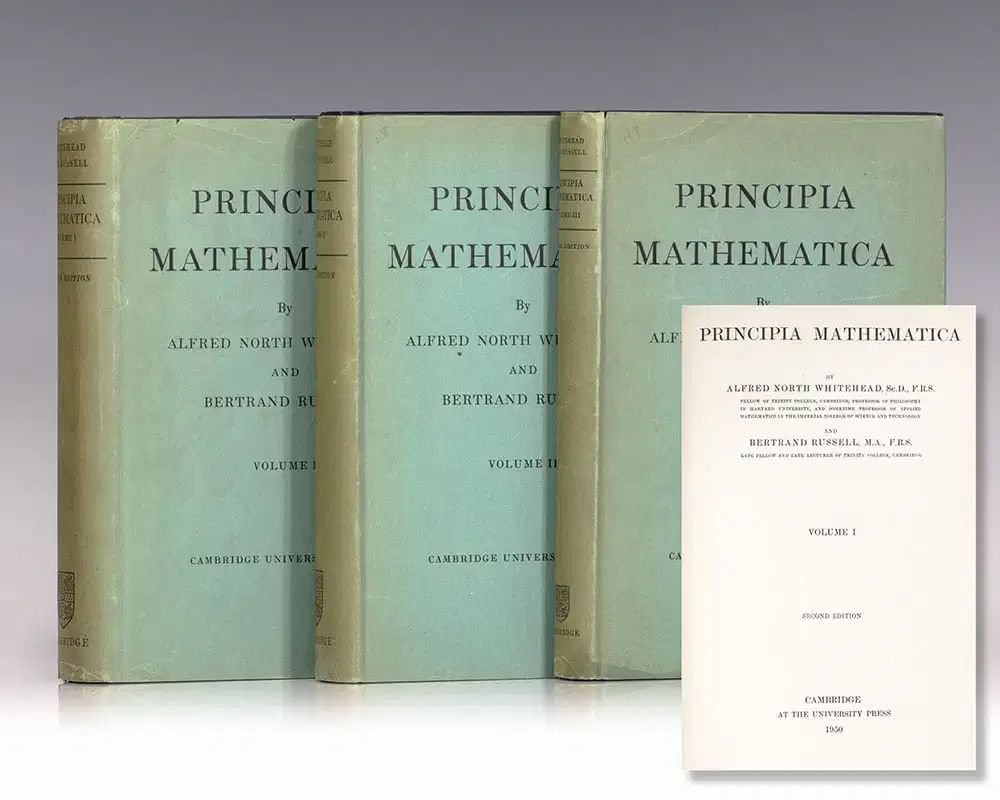
The name “Principia Mathematica” was chosen explicitly as an homage to Newton’s “Principia Mathematica”, which was published 200 years earlier. At the time of the 1900 launch of the Russell-Hilbert project, both Euclid and Newton’s flat interpretations of physical space-time were quickly crumbling with the advent of new discoveries by Riemann, Curie, Weber, Planck and Einstein who were all demonstrating that the shape of physical space-time had a living, creative character. With each creative discovery, a reciprocal interconnectedness between the “subjective” inner space of human cognition and the “objective” outer space of the discoverable universe was ever more firmly established.
Exemplifying this beautiful insight and passion to seek the unknown, which was common among great scientists during this fertile revolutionary period, Einstein stated: “I want to know how God created this world. I am not interested in this or that phenomenon, in the spectrum of this or that element. I want to know His thoughts; the rest are details”.
Reflecting this same view in his own way, Max Planck stated “Science enhances the moral value of life, because it furthers a love of truth and reverence—love of truth displaying itself in the constant endeavor to arrive at a more exact knowledge of the world of mind and matter around us, and reverence, because every advance in knowledge brings us face to face with the mystery of our own being.”
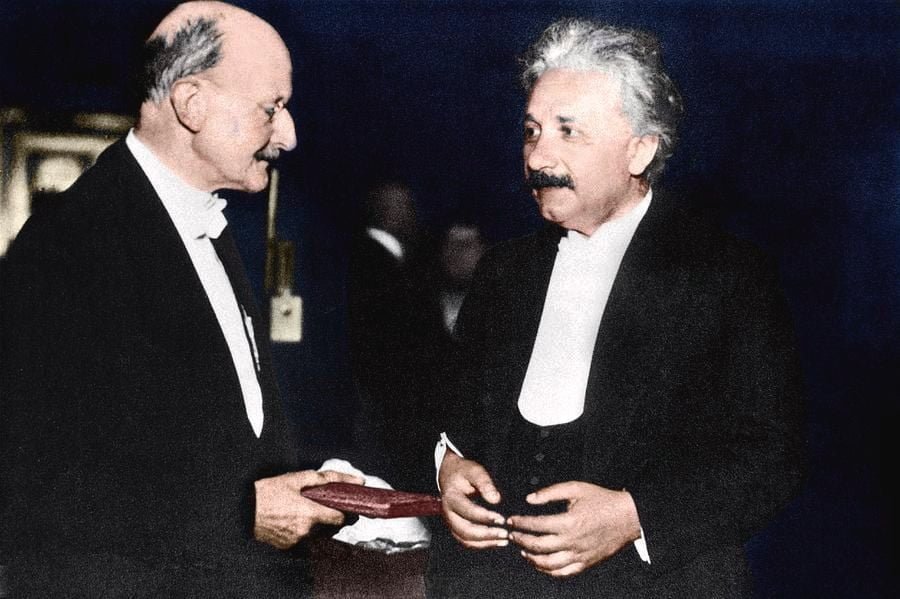
Closed System Entropy Must Define the Universe!
Russell’s closed system entropic mathematics was a direct reflection of his misanthropic view of an entropy-destined humanity which can explicitly be seen in his 1903 statement:
“That man is the product of causes that had no prevision of the end they were achieving; that his origin, his growth, his hopes and fears, his loves and his beliefs, are but the outcome of accidental collocations of atoms; that no fire, no heroism, no intensity of thought and feeling, can preserve individual life beyond the grave; that all the labors of the ages, all the devotion, all the inspiration, all the noonday brightness of human genius, are destined to extinction in the vast death of the solar system, and that the whole temple of Man’s achievement must inevitably be buried beneath the debris of a universe in ruins- all these things, if not quite beyond dispute, are yet so nearly certain that no philosophy which rejects them can hope to stand… Only within the scaffolding of these truths, only on the firm foundation of unyielding despair, can the soul’s habitation henceforth be safely built.”
When pondering which set of metaphysical views has greater claim to truth featured above, it is worth asking the question: Who actually made demonstrable discoveries into creation and who merely formulated ivory tower models devoid of any actual element of discovery?
Part of the formula for success in Russell’s mind hinged on his obsession with mathematical equilibrium in all things. When applied to society, it was no wonder that Russell was a devout Malthusian and life long promoter of eugenics and population control. One of his many displays of such views was made in his 1923 Prospects of Industrial Civilization, where he stated:
“Socialism, especially international socialism, is only possible as a stable system if the population is stationary or nearly so. A slow increase might be coped with by improvements in agricultural methods, but a rapid increase must in the end reduce the whole population to penury… the white population of the world will soon cease to increase. The Asiatic races will be longer, and the negroes still longer, before their birth rate falls sufficiently to make their numbers stable without help of war and pestilence… Until that happens the benefits aimed at by socialism can only be partially realized and the less prolific races will have to defend themselves against the more prolific by methods which are disgusting even if they are necessary.”
Russell’s later writings in The Scientific Outlook (1930) extend his views of a stationary global society onto educational reform where he defines the need to have not one, but two separate modes of education: one for the elite master class, who will become rulers, and one for the inferior slave class.
Russell outlines the two castes in the following terms:
“The scientific rulers will provide one kind of education for ordinary men and women, and another for those who are to become holders of scientific power. Ordinary men and women will be expected to be docile, industrious, punctual, thoughtless, and contented. Of these qualities probably contentment will be considered the most important. In order to produce it, all the researchers of psycho-analysis, behaviourism, and biochemistry will be brought into play…. All the boys and girls will learn from an early age to be what is called `co-operative,’ i.e., to do exactly what everybody is doing. Initiative will be discouraged in these children, and insubordination, without being punished, will be scientifically trained out of them.”
For the ruling class: “Except for the one matter of loyalty to the world State and to their own order,” Russell explained, “members of the governing class will be encouraged to be adventurous and full of initiative. It will be recognized that it is their business to improve scientific technique, and to keep the manual workers contented by means of continual new amusements.”
All of Russell’s later writings promote policies including: the pre-emptive nuclear bombing of Russia, a World Government run by a scientific dictatorship and teaching children to believe that “snow is black” should be read with his racist philosophical worldview in mind.
Norbert Wiener and the Rise of Cybernetics
In 1913, as Russell’s third and final volume of the Principia Mathematica was being printed, a young mathematics protégé arrived at Cambridge from the U.S. on scholarship. His name was Norbert Wiener and he soon found himself among a small group of boys who were closely mentored by Bertrand Russell and David Hilbert. Under Russell, Wiener was taught logic and philosophy while Hilbert taught him differential equations. Speaking of Russell, Wiener said: “when I came to study under Bertrand Russell in England, I learned that I had missed almost every issue of true philosophical significance”. He called Hilbert “the one really universal genius of mathematics”.
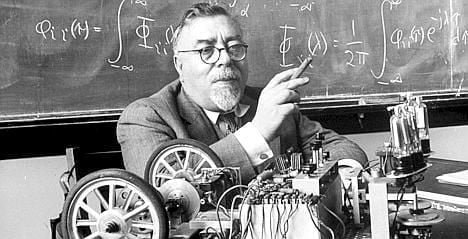
Throughout his entire life, Wiener was possessed by the obsession to express Russell’s logical, closed system in practical ways.
Despite the fact that a young Leibnizian genius named Kurt Gödel threw a major wrench into Russell’s Principia program through his brilliant 1931 demonstration that no logical system could ever be truly consistent with itself due to the self-reflexive nature of all existent systems, Russell pushed forward with the project full force and Wiener was Russell’s leading apostle.
Other Russellites who promoted his theories of machine learning included such names as Alan Turing, Oskar Morgenstern, Claude Shannon and John von Neumann. While each mathematician had their own particular innovation to offer, they were all united by the unwavering faith that a human mind was a mixture of bestial impulses guided by closed-system machine logic and nothing more. In a computer, the whole is but the sum of parts, and it must be as such in all information systems, including human brains, ecosystems and the universe as a whole. “Metaphysical” principles like soul, purpose, God, justice and free will had no place in the minds of these human calculators.

By the end of WWII, Wiener’s work on feedback loops in aeronautics and radar led the mathematician to devise a new language for managing complex human systems, which he soon discovered had applications in business, military affairs and entire nations. The term he gave this new tool of control was “cybernetics”. Describing his invention, Weiner stated:
“Cybernetics, which I derived from the Greek word Kubernetes, or steersman, the same Greek word from which we eventually derive our word governor”.
By relying on binary, closed system computer machines as his model for human minds, Weiner demanded that metaphysical concepts be assumed to not exist beyond the merely physical characteristics of the measurable electrochemical properties of the brain. Describing this computer- mind analog, Weiner stated: “It became clear to us that the ultra rapid computing machine, depending as it does on consecutive switching devices must represent almost an ideal model of the problems arising in the nervous system” and that “the problem of interpreting the nature and varieties of memory in the animal has its parallel in the problem of constructing artificial memories for the machine.”
Cybernetics for Global Governance
Forecasting the inevitability of systems of global information control (and thus total political control by a god-like governing class) as well as artificial intelligence, Weiner wrote:
“where a man’s word goes and where his power of perception goes, to that point his control and in a sense his physical existence is extended. To see and to give commands to the whole world is almost the same as being everywhere.”
The key to understanding the attraction of cybernetics to a scientific dictatorship desirous of total omniscience and omnipotence is the following: In the context of a large boat, only the helmsman need have an idea of the whole. Everyone else need only understand their local, compartmentalized role.
With the application of cybernetics to the organization of economic systems, vast complex bureaucracies emerged with only small nodes of “helmsmen” embedded within the newly emerging “deep state” complex who had access to a vision of the whole. This idea was carried forth by the Organization for Economic Cooperation and Developments’s Sir Alexander King, who co-founded the Club of Rome and helped to apply these ideas across governments of the trans-Atlantic community during the 1960s and 1970s. This system was viewed by its proponents as the perfect operating system for a supranational technocracy to use to control the levers of the New World Order.
One of the most enthusiastic practitioners of this new system during this period of transformation was Pierre Elliot Trudeau (the then-newly imposed Prime Minister of Canada) who shaped a vast cybernetics revolution of the Canadian government between 1968-1972 through Canada’s Privy Council Office. During a November 1969 conference on Cybernetics in Government, Trudeau said:
“We are aware that the many techniques of cybernetics, by transforming the control function and the manipulation of information, will transform our whole society. With this knowledge, we are wide awake, alert, capable of action; no longer are we blind, inert powers of fate.”
Here, Trudeau’s adoration of Cybernetics had been shared by his Russian soul-mate Nikita Khrushchev who rehabilitated the banned “bourgeoisie pseudo science” after Stalin had died. In his October 1961 to the 22nd Party Congress, Khrushchev stated:
“It is imperative to organize wider application of cybernetics, electronic computing and control installations in production, research work, drafting and designing, planning, accounting, statistics and management.”
Trudeau worked closely with Sir Alexander King and Aurelio Peccei in the formation of their new organization the Club of Rome, which has had a profound impact on global governance from 1968 to the present. Trudeau was a devout supporter of this new organization, which soon became a center of neo-Malthusian revivalism during the early years of the 1970s. Trudeau even presided over the Canadian branch of the Club of Rome and allocated money to fund the MIT Club of Rome study “Limits to Growth”, which became a holy book of sorts for the modern environmental organization.

Alexander King and the computer model made famous in the 1972 Limits to Growth imposed a new schism between humanity’s desire to develop vs nature’s supposed desire to rest in mathematical equilibrium. This neo-Malthusian computer model was used to justify the culling of the unfit and overpopulated useless eaters and was subsequently incorporated into the third official World Economic Forum (WEF) meeting at Davos, where Aurelio Peccei was introduced by Klaus Schwab and showcased the Limits to Growth magic to thousands of supportive attendees.
This particular meeting was sponsored by Prince Bernhardt of the Netherlands, a man who had already distinguished himself among upper level managers of the empire by founding the infamous Bilderberg meetings in 1954 and, later, the World Wildlife Fund for Nature in 1961 (alongside Julian Huxley and Prince Philip Mountbatten). In addition to incorporating Club of Rome population models into cybernetics-based planning, this summit also featured the official unveiling of “the Davos Manifesto”, a document which formalized the concept of “Stakeholder Capitalism” and the fourth industrial revolution into the governing manifesto of this “Junior Bilderberger” annual summit.
Unlike Russell, who denied all cases of anti-entropy, Weiner allowed for the existence of isolated islands of limited anti-entropy in the case of biology and human systems which tended to operate in ways that saw entropy (aka: the tendency of systems to collapse into equilibrium) decrease. However, just like Russell, Wiener believed that cybernetics and information theory were shaped entirely by entropy, saying:
“The notion of the amount of information attaches itself very naturally to a classical notion in statistical mechanics: that of entropy.” [aka: the second law of thermodynamics]
In Wiener’s mind, the universe was a decaying finite place shaped by death which would inevitably destroy the limited states of anti-entropic life, life which occurred purely by chance in random parts of “space” and in “time”. Wiener stated the following in 1954:
“[…] it is highly probable that the whole universe around us will die the heat death, in which the world shall be reduced to one vast temperature equilibrium in which nothing really new ever happens. There will be nothing left but a drab uniformity.”
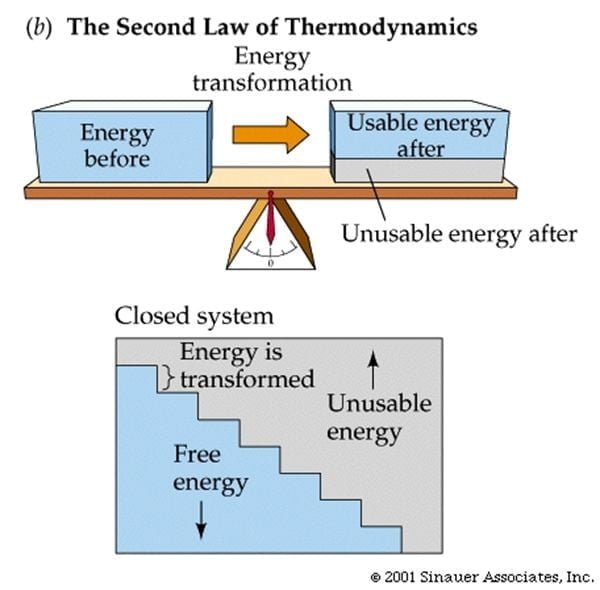
The Macy Conferences on Cybernetics
From 1943 until 1953, Wiener’s cybernetics and his information theory corollary became the rallying point for a new scientific priesthood. This priesthood would gather together leading thinkers of every branch of knowledge, an effort similar to that previously made by Thomas Huxley and his Royal Society X Club.
These conferences were funded by the Josiah Macy Foundation, which had been created by Brigadier General Marlborough Churchill (a cousin of Winston Churchill) in 1930 with the primary aim of moving funds into eugenics research in both the U.S. and Germany, alongside its sister organization The Rockefeller Foundation. The Rockefeller Foundation would fund leading Nazi eugenicist Ernst Rudin from 1928 throughout the entire 1930s, while also sponsoring research led by the British and American eugenics societies.
As Anton Chaitkin points out in his British Psychiatry from Eugenics to Assassination, the Macy Foundation’s founder and controller Gen. Marlborough had formerly headed the military intelligence’s Black Chamber from 1919 until its disbanding in 1929. The Black Chamber interfaced closely with British Intelligence and served as a model for the U.S.’s National Security Agency (NSA). On March 5, 1946, the NSA was integrated into the British Commonwealth intelligence infrastructure with the signing of the UK-USA Signals Intelligence Agreement that gave birth to the “Five Eyes” alliance. It is also no coincidence that this occurred on the very same day that Winston Churchill delivered his infamous “Iron Curtain speech” in Fulton Missouri, which formalized the Cold War.
Starting in 1945 and desperately in need to prevent the spread of the American System of Political Economy and an international New Deal that had been put into motion by president Franklin D. Roosevelt, the Macy Conferences on Cybernetics began meeting every six months. These conferences brought together Tavistock-connected psychiatrists, biologists, neurologists, computer engineers, sociologists, economists, mathematicians, and even theologians. Wiener described these conferences, which shaped the course of Western policy during the next 75 years, saying “for human organization, we sought the help from the anthropologists Doctors [Gregory] Bateson and Margaret Mead while Dr. [Oskar] Morgenstern of the Institute of Advanced Study was our advisor in the significant field of social organization belonging to economic theory…Dr [Kurt] Lewin represented the newer work on the opinion of opinion sampling and the practice of opinion making”.
Social Engineering Drives the Post-War Order
For those who may not know, Dr. Bateson was a leading controller of the CIA’s MK Ultra program, which ran from 1952-1973 as a multi billion-dollar covert operation designed to study the effects of “depatterning” on both individuals and groups using mixtures of electroshock therapy, torture and drugs. Oskar Morgenstern was the innovator of “Game Theory”, which played a dominant role in both military planning of the Vietnam War as well as economic systems for the next 70 years. Dr. Kurt Lewin was a leading psychiatrist from London’s Tavistock Clinic and member of the Frankfurt School that organized a concerted program to eliminate the sickness of national patriotism, belief in truth, and family love throughout the Cold War period.
A prominent conference member and planner of this operation was named Sir Julian Huxley. Huxley was a leading eugenicist and imperial grand strategist who worked closely with fellow Fabian Society leader Bertrand Russell. Huxley shared Russell and Wiener’s devout belief in universal entropy saying in 1953:
“Nowhere in all its vast extant is there any trace of purpose, or even of prospective significance It is impelled from behind by blind physical forces, a gigantic jazz dance of particles and radiations in which the only over-all tendency we have so far been able to detect is that summarized in the second law of thermodynamics- the tendency to run down.”
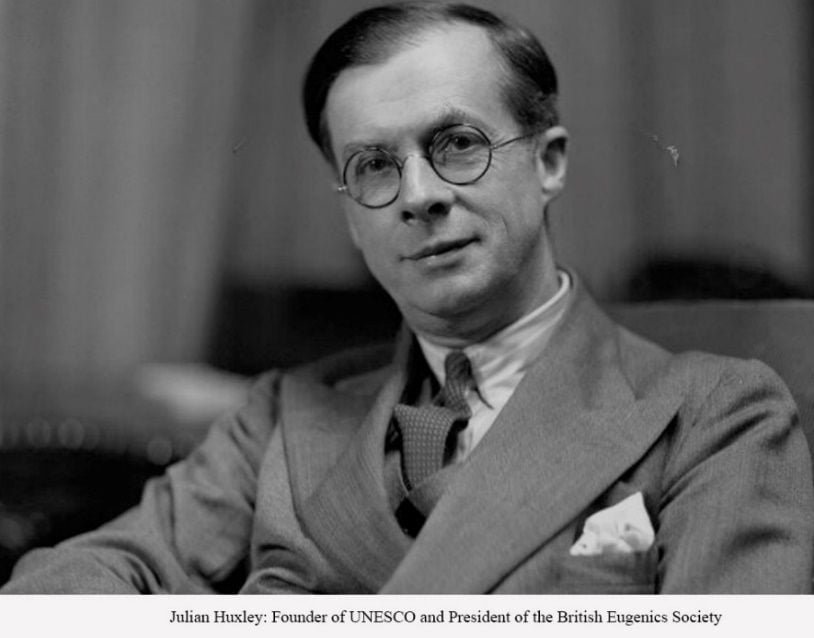
As he was beginning to formulate his concept of “transhumanism” and while he was organizing the Macy Cybernetics Conferences, Julian also found the time to create the United Nations Education Science and Cultural Organization (UNESCO) in 1946, drafting its founding manifesto. His entropic view of biology and physics was clearly expressed in his bone chilling political views wherein he writes:
“The moral for UNESCO is clear. The task laid upon it of promoting peace and security can never be wholly realised through the means assigned to it- education, science and culture. It must envisage some form of world political unity, whether through a single world government or otherwise, as the only certain means of avoiding war… in its educational programme it can stress the ultimate need for a world political unity and familiarize all peoples with the implications of the transfer of full sovereignty from separate nations to a world organization.”
Working in tandem with the World Health Organization- itself created by a Tavistock psychiatrist named G. Brock Chisholm, and funded entirely by the Macy Foundation – Huxley organized the creation of the World Federation of Mental Health (WFMH). WFMH was overseen by the Bank of England’s Montagu Norman and directed by the head of London’s Tavistock Clinic Maj. General John Rawlings Rees, whom Montagu directly appointed.
Chaitkin points out that among the first projects which the WFMH and Macy Foundation jointly organized were the “Conferences on Problems of Health and Human Relations in Germany” in 1949-1950 which ensured that the Frankfurt School’s Authoritarian Personality thesis was drilled into the minds of all German children. The goal was to persuade the German people that the whole fault of Hitler’s rise to power was not to be found in looking for international conspiracies or City of London/Wall Street manipulation… but rather in the “authoritarian psychological-genetic” disposition of the German people themselves. This program was overseen by Tavistock Director Kurt Lewin, who by this time became a leading figure of the Frankfurt School and innovator of a new brainwashing technique called “sensitivity training” which relied heavily on the use of guilt complexes and group pressure to break the will of a target group either in a classroom or in the workplace and absorbing any original thinkers into states of group think. Lewin’s work with the WFMH and Tavistock also became the foundation for today’s Critical Theory doctrines that threaten to undermine the entire scope of western civilization.
To the degree that individuals think for themselves and are inwardly directed by factors of 1) creative reason and 2) conscience, the group-think systems no longer behave according to the sort of statistically predictable rules of entropy and equilibrium, which control-hungry oligarchs and technocrats demand. Erasing that factor of “unpredictability” by making the argument that all leaders who profess truth are simply “authoritarian personalities” and “new Hitler-types”, the virtue of mobs was raised above the virtue of individual genius and initiative which continues to plague the world to this day.
Cybernetics Conferences evolved throughout the 1960s-1970s, finding themselves increasingly integrated with international organizations like the United Nations, World Health Organization, NATO, and OECD. As this integration occurred, the new technocrats became ever more influential in setting the standards of the new world operating system. Meanwhile national governments found themselves increasingly cleansed of nationalist moral leaders like John F. Kennedy, Charles DeGaulle, Enrico Mattei, and John Diefenbaker. This resulted in the deeper integration of both systems analysis and cybernetics into the governing framework of a new transnational power structure.
After Julian Huxley coined the term “transhumanism” in 1957, the cult of Artificial Intelligence – guided by a belief in the inevitable merger of man and machine – grew increasingly with such major events as the man-computer symbiosis thesis of J.C.R Licklider in 1960 and the application of these systems into Department of Defense programs like wargames command systems, SAGE (Semi Automatic Ground Environment), and unmanned jet plane defense networks. DARPA’s Augmented Cognition Computer-Soldier dyads were yet another expression of this perverse idea with hundreds of millions of dollars spent on the creation of enhanced cyborg soldiers.
Over the years, followers of this new cult soon found themselves operating as helmsmen in the new global ship of earth, giving rise to a new global elite class of technocrats and oligarchs who are loyal only to their caste and ideology. They strive to shape their minds ever more closely to the model of idea computing machines capable of logic, but not love or creativity. The more that these cultish technocrats – like Yuval Harari, Ray Kurzweil, Bill Gates or Klaus Schwab – could think like cold computers, while getting the masses of the earth to do the same, the more their thesis that “computers must obviously replace human thought” could be maintained.




